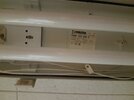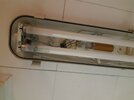- Joined
- 14 Feb 2005
- Messages
- 99
- Reaction score
- 15
- Country

Hi,
I have an old twin tube fluorescent strip light that doesn't come on anymore. The ends of the tubes light up and they look in decent condition.
In our old place our lights had small cylindrical starters that usually needed replacing when this happened. But when I opened this light I don't see any. I googled it and I saw mention of ballast?
Are there starters in these lights (brand Mazda Park STD 236 c)? Mazda are still trading but I couldn't find contact details. Or should I just replace the whole light with an LED? It is in the basement, in the larder and probably gets turned on less than once a day.
Many thanks,
Gill
I have an old twin tube fluorescent strip light that doesn't come on anymore. The ends of the tubes light up and they look in decent condition.
In our old place our lights had small cylindrical starters that usually needed replacing when this happened. But when I opened this light I don't see any. I googled it and I saw mention of ballast?
Are there starters in these lights (brand Mazda Park STD 236 c)? Mazda are still trading but I couldn't find contact details. Or should I just replace the whole light with an LED? It is in the basement, in the larder and probably gets turned on less than once a day.
Many thanks,
Gill




